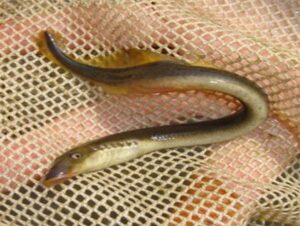Fish of the Severn Estuary European Marine Site
The Severn Estuary and Bristol Channel support one of the most diverse fish assemblages in the UK, with over 110 fish species identified. There are a wide range of migratory species and estuarine specialists, as well as some more typically marine and freshwater species reflecting the influence of the wider Bristol Channel and major rivers entering the Estuary.
The Severn Estuary is a key British estuary for three rare species, which are designated ‘Annex II’ features under the Severn Estuary SAC:
- River lamprey, Lampetra fluviatilis
- Sea lamprey, Petromyzon marinus
- Twaite shad, Alosa fallax
These species, together with salmon, Salmo salar, sea trout, Salmo trutta, eel, Anguilla anguilla and allis shad, Alosa alosa, are also designated features of the Ramsar Site.
The wider assemblage of fish species, which includes the migratory species, estuarine specialists and the marine and freshwater species, is a designated feature of the Ramsar Site and a component of the estuary feature of the SAC.
Migratory fish
River and Sea Lamprey:
River and sea lamprey are a primitive type of fish, belonging to an ancient order of vertebrates. With a distinctive suckered mouth and no jaws, they are unlike most other fish species in the UK. Although the population of lamprey has declined over the last century, they remain widely distributed within the UK. Sea and river lamprey spawn and spend their juvenile phase in fresh water and spend their adult life in the sea or estuaries. The Severn Estuary provides a migratory corridor to and from their spawning and nursery grounds in the rivers. The species occurrence description for both river and sea lamprey is not yet available. They are both designated features of the Severn Estuary SAC.
For more information on river lamprey, click here. For more information on sea lamprey, click here.
Allis and Twaite Shad:
Allis and twaite shad are the only two members of the herring family found in fresh water in the UK. Both species used to be consumed in the UK before the fisheries collapsed; in the middle of the 19th Century, the value of shad rivalled that of salmon and in the River Severn, shad made up over 30% of all landings. Three of the four confirmed UK spawning populations of twaite shad are in the rivers Severn, Usk and Wye. Shad enter the Severn Estuary in spring, usually between April and June, moving up into the rivers to spawn. The Estuary provides a vital feeding and nursery area for juvenile shad, which feed on plankton. The species occurrence description of shad is not yet available for the Severn Estuary. Twaite shad is a designated feature of the Severn Estuary SAC and allis shad is a feature of the Severn Estuary Ramsar site.
For more information on twaite shad, click here.
Salmon, Eels and Sea Trout:
The Severn Estuary supports a key migratory route for salmon, eels and sea trout between their spawning grounds in the upper reaches of the rivers and the open sea. They are designated features of the Severn Estuary Ramsar site. The Severn Estuary has the largest eel run in Great Britain.
Assemblage of fish species:

The assemblage of fish species (over 110 species) is a notable sub-feature of the ‘Estuaries’ feature within both the Severn Estuary SAC and Ramsar site. The assemblage of fish species includes the migratory species, as well as the following:
Estuarine species
- Species typically occurring and breeding in estuaries
- Marine species occurring in large numbers in estuaries
- Examples: sprat, herring, whiting, bib, poor cod, bass and common goby
Marine species
- Species typically occurring infrequently in the Severn Estuary, breeding offshore
- Examples: conger eel, Norway pout, red mullet and plaice
Freshwater species
- Species typically occurring and breeding in freshwater and recorded within the Severn Estuary SAC
- Examples: perch, three-spined stickleback, tench, roach and chub
The Severn Estuary provides important nursery habitat for juvenile fish species and feeding ground for adult fish. Estuaries are often an important habitat for certain life-history stages of fish species that we think of as typically being marine such as cod, bass, sprat and thornback ray. Both the sub-tidal features of the estuary (e.g. Sabellaria reef and the intertidal features such as mudflats and saltmarsh) provide important habitat for many marine and estuarine fish species.
For more information on estuarine, marine and freshwater species, click here.

